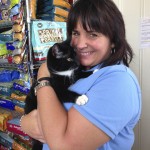I just returned from the Best Friends National Conference. Over 1700 people from across the country and around the globe came together with a shared goal – learning how to better connect homeless pets with people who are seeking pet companions.
So where do people get pets?
That’s an important question for those of us in the human-animal matchmaking business.
40% receive a pet as a gift
33% strays
30% adopted through a rescue or animal control
31% breeders
14% pet stores
(AP-Petside poll; over 100% due to multiple animal homes polled)
 Those numbers are encouraging. Why? Because they tell me that fewer people are buying dogs from pet stores. Too often those “puppies in the window” came from puppy mills, which are the source of unimaginable suffering for the dogs used for breeding. Those numbers tell me approximately 63% of formerly homeless pets found families—whether taken in as strays or adopted through rescue groups or animal control shelters, they now enjoy HOME.
Those numbers are encouraging. Why? Because they tell me that fewer people are buying dogs from pet stores. Too often those “puppies in the window” came from puppy mills, which are the source of unimaginable suffering for the dogs used for breeding. Those numbers tell me approximately 63% of formerly homeless pets found families—whether taken in as strays or adopted through rescue groups or animal control shelters, they now enjoy HOME.
Here’s another fun fact—a “gifted pet” is actually less likely to be relinquished. That’s the opposite of what I’ve heard for years as a rescuer, good to know!
Matchmaking: Human + Animal = Happy ever after
Every person involved in animal welfare wants to make sure that each adopter has “furrever” in mind. That’s why rescue groups, humane associations and animal control organizations have screening processes in place. Not to “weed out” the bad, but rather to find the right fit. Sending a St. Bernard puppy home to a family living in an apartment whose lease has a weight limit will only result in heartache – heartache for the family, the dog and the adoption agency.
 The most important part of the adoption process is seeing the human-animal bond develop. People who have strong connections with their furry companions may be less likely to relinquish their furry family member when circumstances change. Building a relationship with the adoptive family is key to “furrever.” Following up post adoption and providing training and behavior assistance can often keep pups in their families through even the most challenging transitions.
The most important part of the adoption process is seeing the human-animal bond develop. People who have strong connections with their furry companions may be less likely to relinquish their furry family member when circumstances change. Building a relationship with the adoptive family is key to “furrever.” Following up post adoption and providing training and behavior assistance can often keep pups in their families through even the most challenging transitions.
Quiz challenge
The depth of bond between human and companion animal is:
a) Higher in low-income homes
b) The same in high- and low-income homes
c) Higher in high-income homes
 The answer is a) higher in low-income homes. I don’t know all the reasons for this, but I can say that the human-animal bond is powerful. When screening potential adopters the ability to provide care for the pet is important, but it’s only one piece of the puzzle. We all know that financial circumstance can and do change over time. What adoption agencies are really looking for is the bond between human and animal. We all know that strong human-animal relationships can endure hardship.
The answer is a) higher in low-income homes. I don’t know all the reasons for this, but I can say that the human-animal bond is powerful. When screening potential adopters the ability to provide care for the pet is important, but it’s only one piece of the puzzle. We all know that financial circumstance can and do change over time. What adoption agencies are really looking for is the bond between human and animal. We all know that strong human-animal relationships can endure hardship.
Crossroads Campus: Where people and animals connect
 Crossroads exists to promote and encourage the human-animal bond. Everyday the interns at Crossroads Pets (our social enterprise) care for our adoptable pets, helping the pets stay healthy and happy until they go HOME. At every Caring Connections session (our humane education program) children, youth and adults experience the human-animal connection. Each adoption is a celebration of the work done by Crossroads Pets’ interns, volunteers and staff and Caring Connections participants, volunteers, and staff. Together we are making a difference in the lives of people and animals.
Crossroads exists to promote and encourage the human-animal bond. Everyday the interns at Crossroads Pets (our social enterprise) care for our adoptable pets, helping the pets stay healthy and happy until they go HOME. At every Caring Connections session (our humane education program) children, youth and adults experience the human-animal connection. Each adoption is a celebration of the work done by Crossroads Pets’ interns, volunteers and staff and Caring Connections participants, volunteers, and staff. Together we are making a difference in the lives of people and animals.
You can help!
Join the Crossroads Team! There are many different ways you can be part of this amazing team, whether you’re a ‘cat person’ or a ‘dog person’. Or maybe you like working with youth or teens or maybe you’re one of those behind the scenes types looking for a way to plug into a pretty cool organization. We’d love to meet you! Contact Nancy for more information nancy@crossroadscampus.org or 615-712-9758.

